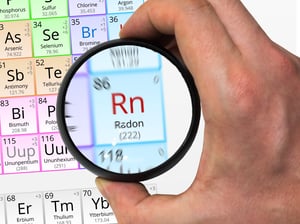
You’ve probably heard of radon – a colorless, odorless, radioactive gas that can seep up from the earth and into your home. It sounds scary, and it can be, but no need to panic. Radon vapor exists in nearly every home, because it occurs naturally as uranium breaks down in the soil.
So how can it be dangerous and yet not dangerous? It’s all about the radon levels – in low amounts, there is no need to worry, but if it’s concentrated in high levels in your home, that’s when it’s dangerous. So how do you know what’s safe for your house? And what can you do to fix it?
Radon and Your Health
Radon can lead to many health issues, including lung cancer in those with long-term exposure. In fact, according to the Minnesota Department of Health (MDH), radon is the second leading cause of lung cancer after tobacco. According to the MDH, over 21,000 lung cancer deaths in the United States are from radon each year.
If you look at the U.S. Environmental Protection Agency’s map of Minnesota radon zones, you’ll see that our state has the geology and climate that makes us prime candidates for high radon levels in our homes. All Minnesota counties are in either moderate or high potential radon zones.
Our resident HVAC and indoor air quality expert, Keith Hill, technical support manager at Minnesota Air, agrees that Minnesota happens to have geology conducive to high levels of radon in our soil. So it should be of concern to every homeowner in the state. That’s why it’s so important to check the levels found in your home.
“The EPA recommends taking action to reduce radon levels indoors if concentrations exceed 4 pCi/L (picocuries per liter of air). However, no safe level of exposure to radon has been determined,” Keith says.
Testing for Radon
You can’t know what radon levels may be in your home unless you test for them. Luckily there are easy, inexpensive ways to check for radon in your home.
Home Radon Tests
There are two types of tests you can use to check radon levels in your home. The first test is a short-term test that takes 3-7 days and is accurate enough to let you know if you need to take further action. The American Lung Association suggests, “two short-term tests back-to-back may be a good way to determine whether you need to take action.”
The second test takes 3 months to a year, and is a very accurate predictor if your home has a radon problem.
“My advice is to start with the quick test, which is also the least expensive,” says Keith, “and then proceed to the long term test, if the quick test results show borderline or high levels." Regardless of which you choose, follow the directions closely to ensure accuracy.
Where to Get Test Kits
Most hardware stores sell kits, but Minnesota residents can purchase discounted radon test kits directly from the manufacturer or MDH partners.
“The good news is that the tests are relatively inexpensive and easy to perform, so there is no reason not to check your home,” according to Keith. He says even if you’ve had your home tested in the past, you may want to do it again if you’ve made changes to your home. New windows, siding, or anything else that may restrict the natural ventilation may cause an increase in radon levels.
Best Time to Test for Radon
“The best time to check for radon is the time of the year when our homes are sealed up the most – winter,” says Keith. “If you test out ‘OK’ during the winter months, you can be sure that the rest of the year your home will have lower radon levels.”
Keith also recommends that “a test should be performed in the lowest occupied level, typically basement bedrooms or other low-level areas that are occupied for extended periods of time.”
Reducing Radon
If tests show that radon levels in your home are low, there are simple steps you can take to reduce those levels.
Improve Ventilation
Ventilation is the easiest and least expensive way to reduce radon levels in your home. According to Keith, “the solution could be as simple as increasing your mechanical ventilation; a well-ventilated home is one of the easiest ways to deal with low levels of radon.”
Not only will exchanging air more often be better for reducing radon, but it also helps reduce other pollutants and VOCs (volatile organic compounds) in your home. “By diluting the tainted indoor air with fresh outside air, the concentration of radon is decreased,” Keith says.
If you’re concerned about heat loss with a better ventilation system, using Heat Recovery Ventilators (HRVs), or air exchangers, is another great way to bring in fresh air in a very energy-efficient manner. HRV systems increase ventilation by introducing outdoor air into your home. If properly balanced and maintained, they ensure a constant degree of ventilation throughout the year.
If you have questions about a simple ventilation system or an HRV, Keith recommends contacting your local HVAC pro to find out about all your options. “Most HVAC contractors are radon savvy and can help you, or they can steer you in the right direction,” he says.
Seal Cracks and Openings in Your Foundation
Sealing the cracks and openings in your foundation is another way to reduce radon levels in your home. Doing so will limit the flow of radon into your home, both reducing levels and making any other radon reduction techniques more effective and cost-efficient. However, it’s important to know that sealing cracks is not a stand-alone fix to radon levels.
Removing Radon
Taking DIY steps to reduce radon levels is all well and good. But if tests show that your radon levels are moderate or high, you need to work with a radon mitigation contractor to determine the best solution for your home.
A Full Radon Abatement System
A radon mitigation contractor can evaluate your home and prescribe a comprehensive radon removal system. That may include installing a better ventilation system, sealing, and/or using other technology. There are many factors that determine what might be the best fix for your home, such as foundation size (full basement/concrete slab or crawl space) and the size and design of your home. Once again, a certified radon contractor can give you reduction options based on your individual circumstances.
Active Sub-Slab Suction
The most common – and reliable – solution to remove radon is with active sub-slab suction. It works by having one or more suction pipes inserted through the floor slab and into the crushed rock or soil underneath. Then a radon vent fan is connected to the suction pipes and draws the gas from below the home and releases it into the outdoor air.
A Note About Well Water
While radon typically comes through the foundation of your home, it can also be present in well water and released into the air in your home when water is used for showering and other household uses. In most cases, radon entering the home through water is a small risk compared with radon entering your home from the soil and is fixed easily by either point of use (at the tap) or point of entry (through a variety of filtration systems). A certified radon contractor can help you decide which solution is the best for your home and circumstances.
Final Recommendations
All homes, new or old, need to be checked for radon and elevated levels need to be reduced. If your home tests for elevated levels of radon (higher than 4pCi/L, which is the level of radon in outdoor air) you need to address it and get those levels reduced. But, it’s absolutely worth the expense, because when done properly, radon levels in your home can be reduced up to 99%.
In Minnesota, you can find a list of radon contractors and mitigation service providers maintained by the Minnesota Department of Health. And you can find more information about radon, radon levels, and removing radon on the EPA’s Guide to Radon Reduction.





